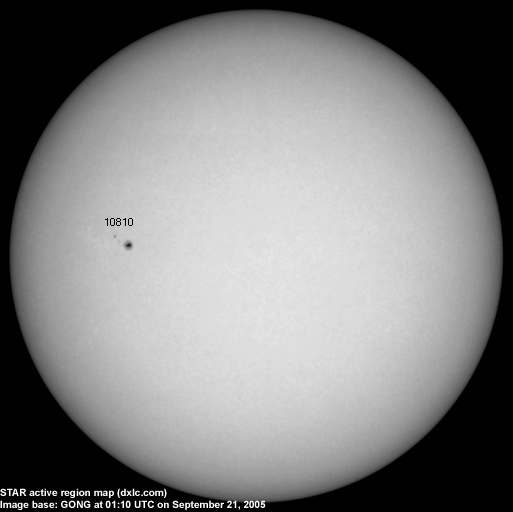

Last major update issued on September 21, 2005 at 03:30 UTC.
[Solar and
geomagnetic data - last month (updated daily)]
[Solar wind and
electron fluence charts (updated daily)]
[Solar cycles 21-23
(last update September 3, 2005)]
[Solar cycles 1-20]
[Graphical comparison
of cycles 21, 22 and 23 (last update September 3, 2005)]
[Graphical
comparison of cycles 2, 10, 13, 17, 20 and 23 (last update September 3,
2005)]
[Historical solar and
geomagnetic data charts 1954-2004 (last update February 1, 2005)]
[Archived reports
(last update September 14, 2005)]
The geomagnetic field was quiet on September 20. Solar wind speed ranged between 348 and 449 (all day average 382) km/sec.
Solar flux measured at 20h UTC on 2.8 GHz was 87.8. The planetary
A
index was 6 (STAR Ap - based on the mean of three hour interval ap
indices: 6.3).
Three hour interval K indices: 12222121 (planetary), 12233221 (Boulder).
The background x-ray flux is at the class B1 level.
At midnight there was 1 spotted region on the visible solar disk. The solar flare activity level was low. A total of 1 C class event was recorded during the day, it was optically uncorrelated.
Region 10810 decayed slightly and was quiet.
September 18-20: No obvious fully or partly Earth directed CMEs were observed.
Coronal hole
history (since late October 2002)
Compare today's report with the situation one solar rotation ago: 28
days ago 27 days ago 26
days ago
No obvious coronal holes are currently approaching Earth-facing positions.

Processed TRACE mosaic image on September 6, 2005. The darkest areas on the solar disk are likely coronal holes.
The geomagnetic field is expected to be mostly quiet on September 21-23.
| Coronal holes (1) | Coronal mass ejections (2) | M and X class flares (3) |
1) Effects from a coronal hole could reach Earth
within the next 5 days. When the high speed stream has arrived
the color changes to green.
2) Material from a CME is likely to impact Earth within 96 hours.
3) There is a possibility of either M or X class flares within the next
48 hours.
Green: 0-20% probability, Yellow: 20-60% probability, Red: 60-100% probability.
Long distance low and medium frequency (below 2 MHz) propagation along east-west paths over high and upper middle latitudes is poor becoming poor to fair. Propagation on long distance northeast-southwest paths is poor. Trans Atlantic propagation conditions are normally monitored every night on 1470 kHz. Dominant stations tonight: Radio Cristal del Uruguay. Other stations from Uruguay were 1590 Radio Real and 1510 Radio San Carlos. Several stations from North America were heard, some with fair signals. Most of the usual Newfoundland stations were audible and from the USA 1130 WBBR and 1510 WWZN had the best signals.

Compare to the previous day's image.
Data for all numbered solar regions according to the Solar Region Summary provided by NOAA/SEC. Comments are my own, as is the STAR spot count (spots observed at or inside a few hours before midnight) and data for regions not numbered by SEC or where SEC has observed no spots. SEC active region numbers in the table below and in the active region map above are the historic SEC/USAF numbers.
| Active region | Date numbered | SEC spot count |
STAR spot count |
Location at midnight | Area | Classification | Comment |
|---|---|---|---|---|---|---|---|
| 10810 | 2005.09.17 | 13 | 7 | N10E37 | 0250 | EAI | beta-gamma classification was EAO at midnight |
| 10811 | 2005.09.19 | S10W13 | plage | ||||
| S592 | 2005.09.18 | N12W26 | plage | ||||
| Total spot count: | 13 | 7 | |||||
| SSN: | 23 | 17 | |||||
| Month | Average solar flux at Earth |
International sunspot number | Smoothed sunspot number |
|---|---|---|---|
| 2000.04 | 184.2 | 125.5 | 120.8 cycle 23 sunspot max. |
| 2000.07 | 202.3 | 170.1 | 119.8 |
| 2001.12 | 235.1 | 132.2 | 114.6 (-0.9) |
| 2004.07 | 119.1 | 51.1 | 40.2 (-1.4) |
| 2004.08 | 109.6 | 40.9 | 39.2 (-1.0) |
| 2004.09 | 103.1 | 27.7 | 37.5 (-1.7) |
| 2004.10 | 105.9 | 48.0 | 35.9 (-1.6) |
| 2004.11 | 113.2 | 43.5 | 35.3 (-0.6) |
| 2004.12 | 94.5 | 17.9 | 35.2 (-0.1) |
| 2005.01 | 102.2 | 31.3 | 34.6 (-0.6) |
| 2005.02 | 97.2 | 29.2 | 33.9 (-0.7) |
| 2005.03 | 89.9 | 24.5 | (33.5 predicted, -0.4) |
| 2005.04 | 86.0 | 24.4 | (32.2 predicted, -1.3) |
| 2005.05 | 99.3 | 42.6 | (29.9 predicted, -2.3) |
| 2005.06 | 93.7 | 39.6 | (28.7 predicted, -1.2) |
| 2005.07 | 96.4 | 39.9 | (27.7 predicted, -1.0) |
| 2005.08 | 90.5 | 36.4 | (25.8 predicted, -1.9) |
| 2005.09 | 97.0 (1) | 30.5 (2) | (24.2 predicted, -1.6) |
1) Running average based on the daily 20:00 UTC observed solar flux
value at 2800 MHz.
2) Unofficial, accumulated value based on the Boulder (NOAA/SEC)
sunspot number. The official international sunspot number is typically
30-50% lower.
This report has been prepared by Jan Alvestad. It is based partly on my own observations and analysis, and partly on data from some of these solar data sources. All time references are to the UTC day. Comments and suggestions are always welcome.
| [DX-Listeners' Club] |